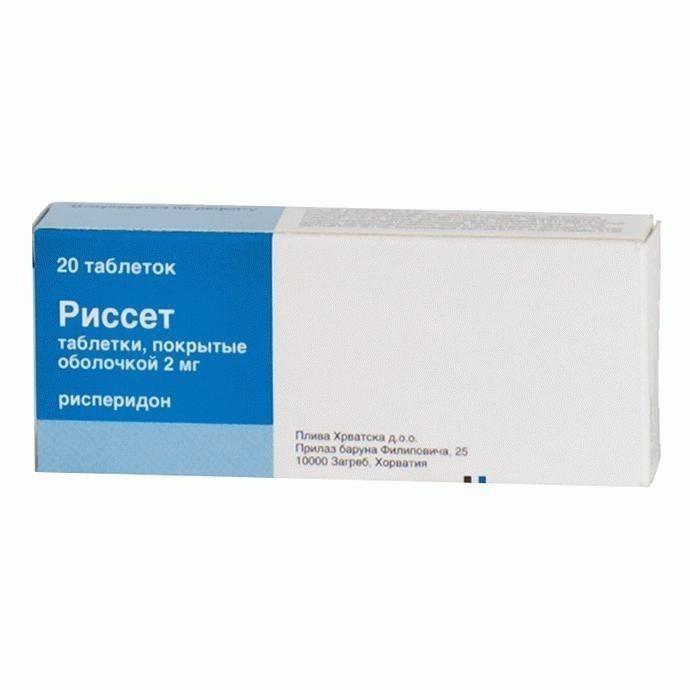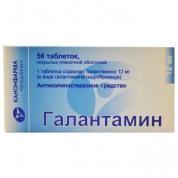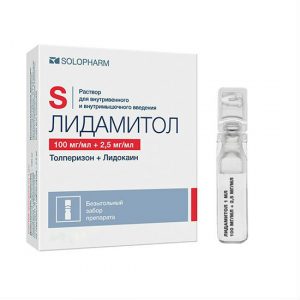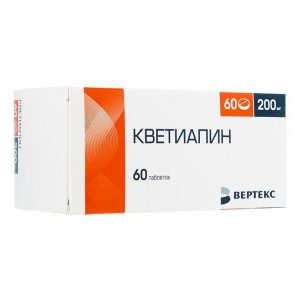Description
Release form
coated tablets
Packing
20 tablets.
Pharmacological action
Risset is an antipsychotic (antipsychotic), a benzisoxazole derivative also has a sedative, antiemetic and hypothermic effect. Selective Monoaminergic Antagonist it has high tropism for serotonergic 5-HT2 and dopaminergic D2 receptors, it also binds to β1-adrenergic receptors, and with a slightly lower affinity, to H1-histaminergic and β2-adrenergic receptors. It has no tropism for cholinergic receptors.
Antipsychotic effect due to blockade of dopamine D2 receptors of the mesolimbic and mesocortical system. Sedative effect is due to blockade of adrenoreceptors of the reticular formation of the brain stem antiemetic effect – blockade of the dopamine D2 receptors of the trigger zone of the vomiting center hypothermic effect – blockade of the dopamine receptors of the hypothalamus.
Suppresses productive symptoms (delirium, hallucinations, aggressiveness), automatism. It causes less suppression of motor activity and less induces catalepsy, than the classic antipsychotic drugs – APS (antipsychotics). Balanced central antagonism of serotonin and dopamine can reduce the tendency to extrapyramidal side effects and expand the therapeutic effect of the drug to cover the negative and affective symptoms of schizophrenia. May induce a dose-dependent increase in plasma prolactin concentration.
Pharmacokinetics
Absorption – fast and complete (food does not affect the completeness and speed of absorption). Absolute bioavailability – 74% relative (tablets compared to solution) – 94%. Tmax in plasma of risperidone – 1 hour of 9-hydroxyrisperidone – 3 hours (with high activity of CYP2D6 isoenzyme) and 17 hours (with low activity of CYP2D6 isoenzyme).
Css risperidone in the body in most patients is achieved within 1 day, and 9-hydroxyrisperidone – 4 5 days. Concentrations of risperidone and 9-hydroxyrisperidone in plasma are proportional to the dose of the drug (in the range of 1 16 mg / day). It is quickly distributed throughout the body, penetrates the central nervous system, breast milk. Vd – 1-2 l / kg. Communication with plasma proteins (c 1-acid glycoprotein and albumin) risperidone – 90%, 9-hydroxyrisperidone – 77%.
Metabolized by the CYP2D6 isoenzyme to the active metabolite of 9-hydroxyrisperidone (risperidone and 9-hydroxyrisperidone make up the active antipsychotic fraction). Another metabolic pathway is N-dealkylation.
T1 / 2 risperidone – 3 hours (with high activity of CYP2D6 isoenzyme) and 20 hours (with low activity of CYP2D6 isoenzyme), T1 / 2 of 9-hydroxyrisperidone – 21 hours (with high activity of the CYP2D6 isoenzyme) and 30 hours (with low activity of the CYP2D6 isoenzyme) of the active antipsychotic fraction – 20 hours
Excreted by the kidneys 70% (35 45% as a pharmacologically active antipsychotic fraction) and with bile (14%).
In chronic renal failure (CRF), creatinine clearance is reduced by 60%.
In liver failure, plasma risperidone levels increase by 35%.
In elderly patients, clearance decreases and T1 / 2 lengthens.
Indications
Relief of acute attacks and prolonged maintenance therapy of the following diseases and conditions: acute and chronic schizophrenia and other psychotic disorders with productive and negative symptoms
affective disorders in schizophrenia
behavioral disorders in patients with dementia with symptoms of aggressiveness (outbreaks of anger, physical abuse), impaired activity (agitation, delirium) or psychotic symptoms of srdlk in adolescents from 15 years old and adult patients with reduced intellectual level or mental retardation in cases where destructive behavior ue (aggression, impulsivity, autoaggression) is a leading clinical disease treatment
mania in bipolar affective disorders (as a means of adjuvant therapy in order to mood stabilization).
Contraindications
hypersensitivity to the components of the drug
lactation period
children under 15 years of age (efficacy and safety not established)
mania in bipolar affective disorders in children under the age of 18 (efficacy and safety not established)
deficiency lactose, glucose-galactose malabsorption.
Precautions: CCC diseases (chronic heart failure, myocardial infarction, cardiac muscle conduction disturbances) conditions, predisposing to the development of pirouette type tachycardia (bradycardia, electrolyte imbalance, concomitant use of drugs that prolong the QT interval) risk factors for venous thromboembolism, dehydration and hypovolemia, cerebrovascular accident, brain tumor, including pituitary prolactinoma Parkinson’s disease Levy’s disease of diffuse bodies convulsions (including a history of) severe renal failure severe liver failure drug abuse or intestinal obstruction acute drug overdose Reye syndrome (antiemetic effect of risperidone may mask the symptoms of these conditions) pregnancy patients with dementia.
Special instructions
In case of schizophrenia, before treatment with risperidone, it is recommended to gradually cancel the previous therapy, if it is clinically justified. If patients are transferred with therapy with depot forms of APS, then it is recommended to start taking instead of the next planned injection. Periodically, the need to continue current therapy with antiparkinsonian drugs should be assessed.
Risperidone in children can only be prescribed by a doctor who has special training in child psychiatry.
Risperidone should be used with caution in elderly patients with dementia, including when taking furosemide and other diuretics.
A meta-analysis of 17 controlled clinical trials showed increased mortality in elderly patients with dementia (mean age 86 years), receiving atypical APS, including risperidone compared with placebo. Among patients receiving risperidone and placebo, mortality was respectively 4 and 3.1%.
For elderly patients with dementia taking risperidone, there was an increased mortality in patients taking furosemide and risperidone compared with the group taking only risperidone and the group taking furosemide only. No pathophysiological mechanisms explaining this observation have been established. No increase in mortality was found in elderly patients who were simultaneously taking other diuretics along with risperidone. Regardless of treatment, dehydration is a common risk factor for mortality and should be closely monitored in elderly patients with dementia.
In a placebo-controlled study, an increased incidence of cerebrovascular accidents (stroke and / or transient ischemic attacks) was found, including fatal in elderly patients with dementia who received some atypical APS, including risperidone, compared with placebo.
In patients with CCC diseases, as well as with dehydration, hypovolemia or cerebrovascular disorders, the dose should be increased gradually. If orthostatic hypotension occurs, especially in the initial period of dose selection, a dose reduction should be considered.
APS, including risperidone contributes to the development of thromboembolic complications in patients with a tendency to form blood clots. Before starting risperidone therapy, it is necessary to identify all possible risk factors for the development of venous thromboembolism and take appropriate measures to prevent the development of thromboembolic complications.
The risk of developing mania or hypomania can be significantly reduced by using low doses or gradually increasing them.
If signs and symptoms of tardive dyskinesia or malignant antipsychotic syndrome occur, it is necessary to cancel all APS, including risperidone, conduct symptomatic therapy and consider resuming treatment of APS. To prevent the development of malignant antipsychotic syndrome during treatment with APS, it is necessary to regularly adjust the dose taken. It is necessary to carefully evaluate the ratio of potential benefits and possible risks before using risperidone in patients with diffuse Lewy body disease and Parkinson’s disease, since such patients may have an increased risk of developing malignant antipsychotic syndrome and increased sensitivity to APS. With the abolition of carbamazepine and other inducers of microsomal liver enzymes, the dose of risperidone should be reduced.
Patients should be advised to refrain from overeating due to the possibility of increasing body weight.
Influence on the ability to drive a car and work with machinery. During the treatment period, care must be taken when driving vehicles and engaging in other potentially dangerous activities that require an increased concentration of attention and speed of psychomotor reactions.
Dosage and Administration
Inside.
Schizophrenia
1 or 2 times a day. The initial dose is 2 mg / day. On the 2nd day, the dose should be increased to 4 mg / day. From this moment, the dose can either be maintained at the same level, or, if necessary, adjusted individually. Usually the optimal dose is 4-6 mg / day. In some cases, for example, in patients with a first-time episode of the disease, a slower dose increase and lower initial and maintenance doses may be warranted.
When used in doses of more than 10 mg / day, there was no increase in the therapeutic effect compared to lower doses, and extrapyramidal symptoms may appear. The maximum daily dose is 16 mg.
For elderly patients, an initial dose of 0.5 mg 2 times a day is recommended. If necessary, the dose can be increased to 1-2 mg 2 times a day.
For diseases of the liver and kidneys, an initial dose of 0.5 mg 2 times a day is recommended. This dose can gradually be increased to 1-2 mg 2 times a day.
Behavioral disorders in patients with dementia
For most patients, the optimal dose is 0.5 mg 2 times a day. The dose can be increased by no more than 0.5 mg, no more than every other day. However, some patients are shown taking 1 mg 2 times a day. Upon reaching the optimal dose, administration once a day may be recommended.
Behavioral disorders in patients with mental retardation
The initial dose is 0.5 mg once daily. The dose can be increased by no more than 0.5 mg, no more than every other day. The usual maintenance dose is 1 mg 1 time per day. The dosage interval is 0.5-1.5 mg once a day.
Mania for bipolar affective disorder
The initial dose is 2 mg once a day. Next, the dose is selected individually, increasing it by 1 mg / day, no more than every other day. In most cases, the optimal dose is 2-6 mg / day.
As with any symptomatic therapy, during treatment, effectiveness should be evaluated and the dosage regimen adjusted if necessary.
For elderly patients, an initial dose of 0.5 mg 2 times a day is recommended. If necessary, increase the dose to 1-2 mg 2 times a day.
For diseases of the liver and kidneys, an initial dose of 0.5 mg 2 times a day is recommended. The dose can gradually be increased to 1-2 mg 2 times a day.
Side effects of
From the central and peripheral nervous system: insomnia, agitation, anxiety, headache drowsiness, increased fatigue, dizziness, decreased ability to concentrate, blurred visual perception mania, hypomania, extrapyramidal symptoms (tremor, rigidity, bradykinesia, akathisia, acute dystonia).
In patients with schizophrenia – hypervolemia (either due to polydipsia or due to the syndrome of inadequate secretion of ADH), tardive dyskinesia (involuntary rhythmic movements of the tongue and / or face), malignant antipsychotic syndrome (hyperthermia, muscular rigidity, instability, impaired consciousness and increased activity of CPK), violations of thermoregulation and epileptic seizures.
From the digestive system: constipation, dyspepsia, nausea or vomiting, abdominal pain, increased activity of hepatic transaminases, dry oral mucosa, hypo-or hypersalivation, anorexia, increased appetite.
From the CCC side: orthostatic hypotension, reflex tachycardia, increased blood pressure, lengthening of the QT interval, ventricular arrhythmia such as pirouette, ventricular fibrillation, stroke and transient ischemic attacks (in elderly patients with dementia), venous thromboembolism, including thromboembolism of pulmonary vessels and deep veins.
From the hemopoietic system: neutropenia, thrombocytopenia.
From the endocrine system: galactorrhea, gynecomastia, menstrual irregularities, amenorrhea, increase or decrease in body weight, hyperglycemia and exacerbation of preexisting diabetes mellitus.
From the reproductive system: priapism, erectile dysfunction, ejaculation disorders, anorgasmia.
Urinary system: urinary incontinence, urinary tract infection.
From the skin: dry skin, hyperpigmentation, itching, seborrhea.
Allergic reactions: rhinitis, rash, angioedema, photosensitivity.
Other: arthralgia.
Drug interactions
Given that risperidone primarily affects the central nervous system, it should be used with caution in combination with other centrally acting drugs and with alcohol.
Risperidone decreases the effectiveness of levodopa and other dopamine agonists.
Clozapine reduces risperidone clearance.
When using carbamazepine, a decrease in the concentration of the active antipsychotic fraction of risperidone in plasma was noted. Similar effects can be observed when using other inducers of hepatic enzymes.
Phenothiazines, tricyclic antidepressants, and certain -adrenoblockers can increase plasma risperidone concentrations, but this does not affect the concentration of the active antipsychotic fraction.
Fluoxetine can increase the concentration of risperidone in the plasma, but to a lesser extent the concentration of the active antipsychotic fraction, so the dose of risperidone should be adjusted.
When using risperidone together with other drugs that bind to plasma proteins to a high degree, there is no clinically pronounced displacement of any drug from the protein fraction of plasma.
Antihypertensive drugs increase the severity of lowering blood pressure with risperidone.
Overdose
Symptoms: drowsiness, sedation, depression of consciousness, tachycardia, hypotension, extrapyramidal disorders, in rare cases prolongation of the QT interval.
Treatment: it is necessary to ensure the free passage of the respiratory tract to ensure adequate oxygenation and ventilation, gastric lavage (after intubation, if unconscious) and the appointment of activated charcoal in combination with laxatives. Symptomatic therapy aimed at maintaining vital functions of the body. To timely diagnose possible heart rhythm disorders, ECG monitoring should be started as soon as possible. Careful medical monitoring and ECG monitoring are performed until the symptoms of intoxication disappear. There is no specific antidote.
Storage Conditions
In a dry, dark place at a temperature not exceeding 25 ° C.
shelf life
3 years
Deystvuyushtee substance
Risperidone
Conditions of sale from
pharmacies Prescription
dosage form
tablets
needles Possible product names
NISLET 0.00 TISSET / About
Risset 2mg Tab. n / a X20 (R)
Risset 2mg Tab. p / pl / rev X20 (R)
Risset 2mg Tab./P.O X20! Until 02.10./
Risset tab p / pl / o 2mg x 20




